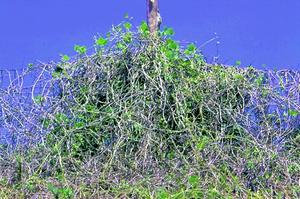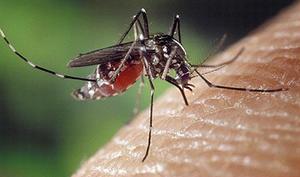GENEVA, Switzerland, July 19, 2012 (ENS) – World Trade Organization rules on food safety and animal and plant health can be used to control environmental damage caused by alien and invasive species crossing borders into new habitats, a WTO seminar agreed last week.
Species that are in balance in one ecosystem can become invasive if they are introduced into another habitat. There are many: fast-growing kudzu plants, Asian wild raspberry bushes, Asian longhorn beetles, Burmese pythons, northern Pacific seastars, fire trees, fire ants, crazy ants, blue mussels, zebra mussels, mice, rats, pigs, goats and deer, to name just a few.
 |
Kudzu infestation (Photo by James H. Miller) |
Alien species are those that are introduced into new habitats; they are invasive if they thrive so much that they threaten biodiversity, which includes agricultural and domestic species as well as wildlife.
The threats include competition for food, the spread of disease or the spread of predators.
Trade is a major pathway by which alien species can be introduced into new habitats. That includes the unintended spread in shipments of goods.
Alien species can also be spread through direct trade in the species themselves as farm animals or crops, domestic pets or ornamental plants, or predators introduced to control pests.
 |
Burmese python in the Florida Everglades (Photo by Skip Snow, National Park Service, courtesy U. Florida) |
Burmese pythons, for example, which can grow to 16 feet in length, are one of the world’s worst invasive species. Released by pet owners into the wetlands of Florida’s Everglades National Park, they proliferated. Now an estimated 30,000 Burmese pythons prey on endangered birds and alligators.
The Asian tiger mosquito is another of world’s worst invasive species. Linked to the transmission of many human diseases, including dengue fever, West Nile virus and Japanese encephalitis, these mosquitos are spread through the international tire trade in the rainwater retained in the tires when they are stored outside.
The coypu is a large semi-aquatic rodent which originated from South America. Due to escapes and releases from fur farms there are now large feral populations in North America, Europe and Asia. Their burrows penetrate and damage river banks, dykes and irrigation facilities. Their feeding methods lead to the destruction of large areas of reed swamp. Habitat loss caused by coypus harms plant, insect, bird and fish species.
 |
Aedes albopictus mosquito on human skin (Photo by James Gathany, Centers for Disease Control and Prevention, USA) |
The WTO rules govern trade measures on food safety and animal and plant health to avoid their use as an excuse for protectionism that would shield producers from import competition, rather than protecting health or the environment.
Set out in the Sanitary and Phytosanitary Measures Agreement, the rules do this by requiring measures to control the spread of destructive animals and plants to be based on a scientific analysis of risk or on recognized international standards.
The seminar on International Trade and Invasive Alien Species July 12 and 13 was co-organized by the Standards and Trade Development Facility, a partnership of international organizations that helps developing countries deal with international standards on food safety and animal and plant health.
Two of the three standards-setting organizations recognized in the SPS Agreement served as co-organizers – the International Plant Protection Convention, IPCC, and World Organisation for Animal Health, OIE.
 |
Invasive rat attacks the nest of a New Zealand fantail. (Photo by David Mudge) |
Delegates from the World Health Organization and the UN Food and Agriculture Organization and organizations in the Pacific, Caribbean, North America and Europe participated together with representatives of agencies in the United States, European Union, New Zealand, Kenya, Sudan, Brazil, South Africa, Indonesia and elsewhere.
Speakers and participants described how the problem is being tackled in their countries or regions.
Representatives of the private sector, sometimes seen as culprits in the spread of alien species, described how their industries can contribute to the solution.
Climate change is set to drive the spread of invasive plant and animal species, threatening forests, fisheries and crops, in a double blow to nature and livelihoods, according to a World Bank-funded report released in 2010. “The estimated damage from invasive species worldwide totals more than $1.4 trillion annually – 5 percent of the global economy,” according to the report.
One of the newest pathways for intentional introductions is mail order shopping through the Internet.
Seminar participants agreed that strengthening capacity under the Sanitary and Phytosanitary Measures Agreement is the first line of defense in managing the risks linked to invasive alien species.
Key actions were identified to better control invasive alien species:
- boosting efforts to improve the way the international organizations work together, support each other and strengthen each other’s ability to implement the SPS Agreement and global biodiversity conventions
- ensuring existing international standards are implemented better, to prevent trade from spreading harmful alien species and developing new standards where needed
- strengthening developing countries’ ability to undertake scientific risk analysis
- improving coordination among ministries and other agencies within countries, between countries and within regions. The agencies’ concerned have diverse responsibilities, from law enforcement, customs and trade to agriculture, fisheries, forestry and environmental protection
- enhancing cooperation between governments and industry
- raising public and political awareness
- studying potential risks associated with the growth in Internet trade, and how to address them
Click here to see “One Hundred of the World’s Worst Invasive Alien Species” from the Global Invasive Species Database managed by the Invasive Species Specialist Group of the International Union for the Cconservation of Nature’s Species Survival Commission.
Copyright Environment News Service (ENS) 2012. All rights reserved.
